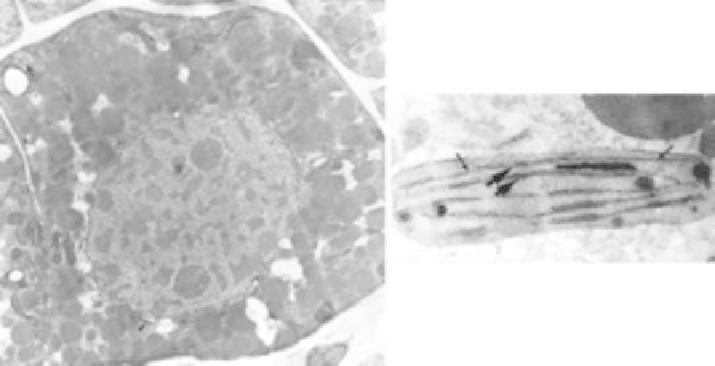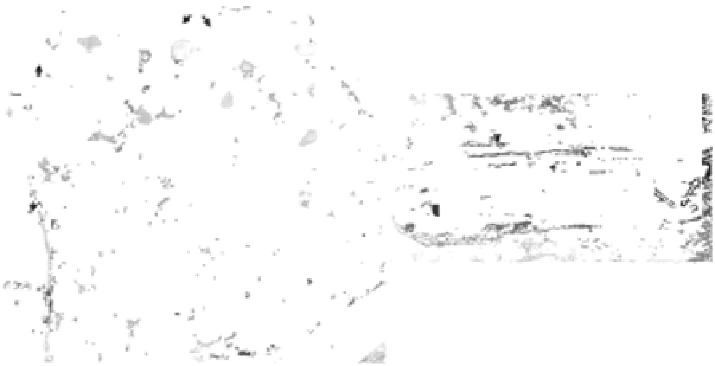Biomedical Engineering Reference
In-Depth Information
M
PL
CW
SG
PL
L
M
SG
PL
L
ER
TH
TH
SG
L
GR
L
ER
N
PG
V
V
L
V
CW
G
FIGURE 26.1
The.architecture.of.a.plant.cell..Transmission.electron.micrographs.showing.a.plant.cell.(left.panel).and.a.develop-
ing.chloroplast.(right.panel)..The.plant.cell.is.surrounded.by.a.thick.cell.wall.(CW).and.is.highly.cytoplasmic,.with.
a.large.nucleus.(N),.several.small.vacuoles.(V),.lipid.droplets.(L),.golgi.bodies.(G),.mitochondria.(M),.endoplasmic.
reticulum.(ER),.and.plastids.(PL).containing.large.starch.grains.(SG)..The.developing.chloroplast.is.stained.to.detect.
carbohydrates,.such.that.the.starch.grain.appears.black..Thylakoid.membranes.(TH).are.well.developed,.with.some.
arranged.into.granal.stacks.(GR)..Small.lipid.deposits,.or.plastoglobuli.(PG),.are.also.present.with.the.chloroplast.
of.photons.into.electric.potential..In.2003,.the.complete.structure.of.the.PSI.protein.com-
plex.from.a.pea.was.determined.by.x-ray.crystallography.
10
.The.structure.of.PSI.is.shown.
in.Figure 26.2.
The.PSI.protein.(in.red.in.Figure 26.2).complexes.and.organizes.approximately.200.chlo-
rophyll. pigment. molecules. (shown. in. blue. in. Figure 26.2).. Despite. its. complexity,. PSI. is.
highly.eficient,.and.almost.every.photon.absorbed.results.in.excitation.of.the.special.chlo-
rophyll.pair.that.converts.the.photon.energy.into.+/-.charge.separation..In.the.plant,.this.
potential.is.used.to.create.ATP..Progress.has.been.made.toward.harnessing.photosynthe-
sis.to.create.hybrid.nanodevices.and.electric.potential..Some.of.this.work.is.discussed.in.
Section.26.7.
26.2.2 The Cell Wall
The. cell. wall. consists. primarily. of. cell. wall. polysaccharides,. with. cellulose. microibrils.
representing. the. primary. structural. units,. embedded. in. a. matrix. of. hemicellulose. and.
pectin,.as.well.as.secondary.wall.lignin,.with.a.smaller,.but.functionally.relevant,.comple-
ment.of.proteins..This.tough.barrier.often.presents.an.obstacle.for.transport.of.materials.
into.the.plant.cell..Some.unique.features.of.nanomaterials.that.can.penetrate.this.barrier.
will.be.highlighted.in.later.sections..An.alternative.biochemical.technology.for.studying.
plant.biochemistry.involves.removing.or.digesting.this.cell.wall.with.cellulase,.hemicellu-
lase,.and.pectinase.enzymes,.leaving.a.cell.membrane.more.reminiscent.of.an.animal.cell,.
which.contains.the.cytoplasm,.nucleus,.mitochondria,.chloroplasts,.and.other.organelles..
The.resulting.package.is.called.a.protoplast,.and.in.this.state,.the.plant.cell.biochemical.
machinery.can.still.function..Since.there.is.only.a.cell.membrane,.most.of.the.usual.animal.
cell. methods. for. material. transfer. across. the. membrane. can. be. employed.. After. experi-
mental. drug. delivery,. gene. insertion,. or. other. protocols,. regrowth. of. the. cell. wall. to. an.


